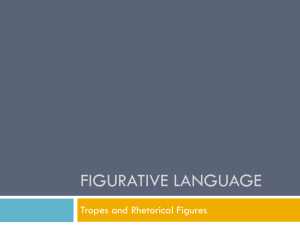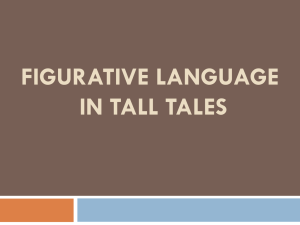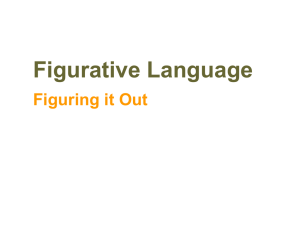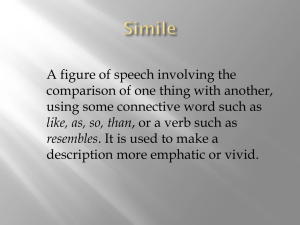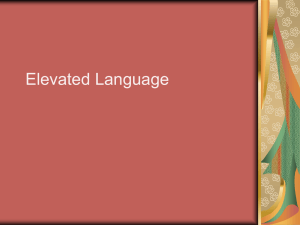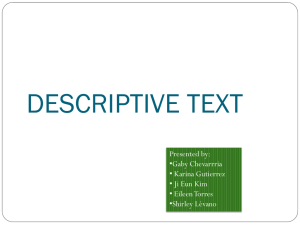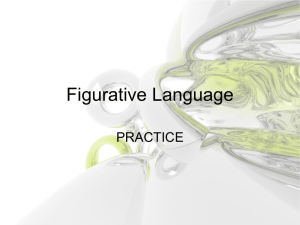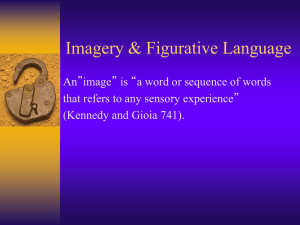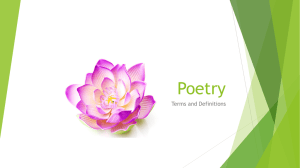Figurative Language
advertisement
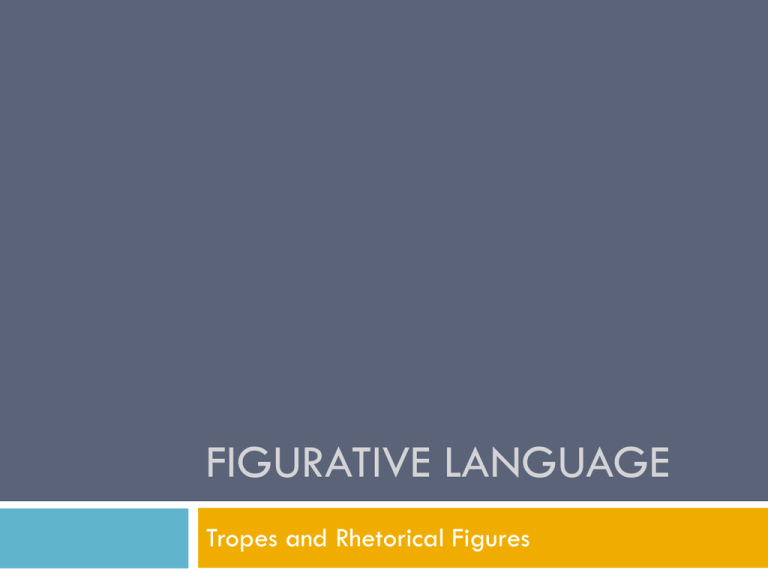
FIGURATIVE LANGUAGE Tropes and Rhetorical Figures The difference between the language of science and the language of literature The special language of science uses words and expressions that communicate one thing at a time without the danger of confusion or of multiple interpretations. Polytetrafluoroethylene probably means the same thing every sentence in which it appears. It is hard to imagine a circumstance where it could be used ironically and it is unlikely to find its way into a simile or metaphor. The language of literature and common life, however, is filled with words and expressions used figuratively, words that mean in a particular context something more than any dictionary definition would lead us to expect. The figures of speech that create these extra meanings are traditionally divided into TROPES (figures that change the meaning of a word) and RHETORICAL FIGURES (those that change the tone or emphasis of a statement without changing the meaning of individual words). The Principal Tropes: metaphor, symbol, simile, personification trope (n). a figurative or metaphorical use of a word or expression METAPHOR—A figure of speech that makes a comparison between two unlike things without the use of such specific words of comparison as like, as, than, or resembles. There are several kinds of metaphor 1. 2. Directly Stated Metaphor Implied Metaphor “Fame is a bee” “I like to see it lap the Miles” 1. 2. 3. Extended Metaphor Fame is a bee / It has a song— / It has a sting— / Ah, too, it has a wing 3. 4. Dead Metaphor Mixed Metaphor 5. A metaphor that is extended or developed over a number of lines or with several examples “The head of the house” 4. 5. Does not state explicitly the two terms of comparison. The example is an implied metaphor in which the verb lap implies a comparison between “it” (which is a train) and some animal that “laps” up water. Used so often the comparison is no longer vivid. A metaphor that fails to make a logical comparison because its mixed terms are visually or imaginatively incompatible. If you say “The President is a lame duck who is running out of gas,” you’ve lost control of your metaphor and have produced a statement that is ridiculous (ducks do not run out of gas). SYMBOL—A person, place, thing, or event that has meaning in itself and that also stands for something more than itself. 1. 2. We can distinguish between two types of symbols: Public Personal __Public_____ symbols The dove, for example, is a public symbol of peace—that is, it is widely accepted the world over as such a symbol. Uncle Sam is a public symbol that stands for the United States. A picture of a skull and crossbones is a public symbol of of Two snakes coiled around a staff is a widely accepted symbol of __death or warning or pirates____ __medicine____ Waving a white flag is a public symbol of __surrender____ __Personal____ symbols Most symbols used in literature are personal symbols; even though a symbol may be widely used, a writer will usually adapt it in some imaginative, personal way so that it can suggest not just one, but a myriad of meanings. One of the most commonly used symbols in literature, for example, is the journey, which can stand for a search for truth, for redemption from evil, or for discovery of the self and freedom. The journey of Huck Finn and Jim down the Mississippi River has been interpreted to symbolize all of these concepts, and more. The marigolds in “Marigolds” symbolize __beauty and possibly guilt____ SIMILE a figure of speech that makes an explicit comparison between two unlike things, using a word such as like, as, than, or resembles. What happens to a dream deferred? Does it dry up like a raisin in the sun? The simile compares __postponed dreams____to __A Raisin in the Sun____ PERSONIFICATION a figure of speech in which an object or animal is given human feelings, thoughts, or attitudes. The cruel wind tore off the roof of the house. What is the object or animal being personified? __wind____ What is the human trait given to the object? __cruelty____ What effect does this give to the object? Meaning, how does this example of personification help readers to visualize/interpret the thing being described? __nastiness and harsh wind___ The Principle Rhetorical Figures: irony, hyperbole, and oxymoron RHETORICAL FIGURES (figurative language that changes the tone or emphasis of a statement without changing the meaning of individual words). rhetoric: (n) language with a persuasive or impressive effect Types of Irony Verbal Irony occurs when someone says one thing but really means something else. For example: Sarcasm Types of Irony Situational Irony takes place when there is a discrepancy between what is expected to happen, or what would be appropriate to happen, and what really does happen. Types of Irony Dramatic Irony is so called because it is often used on stage. It occurs when a character in the play or story thinks one thing is true, but the audience or reader knows better. hyperbole (hi-purr-buh-lee) [never say “hyper-bowl!!!”] a figure of speech that uses an incredible exaggeration, or overstatement, for effect. In Life on the Mississippi, Mark Twain uses hyperbole for comic effect. An example is Twain’s response when Mr. Bixby tells him he must learn the shape of the Mississippi River throughout its course: Have I got to learn the shape of the river according to all these five hundred thousand different ways? If I tried to carry all that cargo in my head it would make me stoop-shouldered. oxymoron a figure of speech that combines opposite or contradictory terms in a brief phrase. “Sweet sorrow,” “deafening silence,” and “living death” are common oxymorons (jokesters include “jumbo shrimp”) Additional Terms to Know Foreshadowing: Hints or clues about what may happen later in the story Alliteration: When a series of words begin with the same later or sound Allusion: A reference to art, literature, events or historical figures Tone: The author’s attitude toward a subject, conveyed through diction Ex: playful, serious, informal, ironic, etc… Mood: The atmosphere that pervades a literary work with the intention of evoking a certain emotion or feeling from the audience. It can be conveyed through imagery and setting. Ex: Gloomy, desperate, romantic, cheerful, etc… Apostrophe: A figure of speech in which someone absent, inanimate, or dead is addressed as if present, or able to reply. “I feel again the chaotic emotions of adolescence, illusive as smoke, yet as real as the potted geranium before me now.” The simile compares the chaotic emotions of adolescence to smoke and the realness of a potted geranium. The comparison suggests that the first object in the comparison is both hard to grasp and solid as an everyday object and it develops… “Joy and rage and wild animal gladness and shame become tangled together in the multicolored skein of a 14-going-on15…” The metaphor compares The emotions of teen years: joy, rage, wild happiness, and shame to A piece of multicolored yarn The comparison suggests that the first object/person in the comparison is The emotions are so woven together that no matter how much one might try to separate them she can’t and it develops… “Poverty was the cage in which we all were trapped…” The metaphor compares Poverty A cage The comparison suggests that the first object/person in the comparison is Poverty to is something that we can not escape and it develops… “…those days are ill-defined in my memory, running together and combining like a fresh water-color painting left out in the rain.” The simile compares The ill-defined days to a water-color painting left out in the rain The comparison suggests that the first object/person in the comparison is the days blended together so much that she could not tell one from another and it develops… “…the oriole nest in the elm was untenanted and rocked back and forth like an empty cradle.” The simile compares The empty bird’s nest to Empty cradle The comparison suggests that the first object/person in the comparison is Sad and lonely and it develops… “…and now if an oriole sings in the elm, its song seems to die up in the leaves, a silvery dust.” The metaphor/personification compares The death of the oriole’s song to A silvery dust The comparison suggests that the first object/person in the comparison is The song’s death is beautiful and ethereal and it develops… “In May and June there was no rain and the crops withered, curled up, then died under the thirsty sun.” The personification compares Dying crops due to the heat of the to Parched sun The comparison suggests that the first object/person in the comparison is The sun was intense and it develops… “We were down in Old Woman Swamp and it was spring and the sick-sweet smell of bay flowers hung everywhere like a mournful song. ‘I’m going to teach you to walk, Doodle,’ I said.” The simile compares The sick-sweet smell of bay flowers to A mournful song The comparison suggests that the first object/person in the comparison is The scent of the flowers was heavy and sad and it develops…

